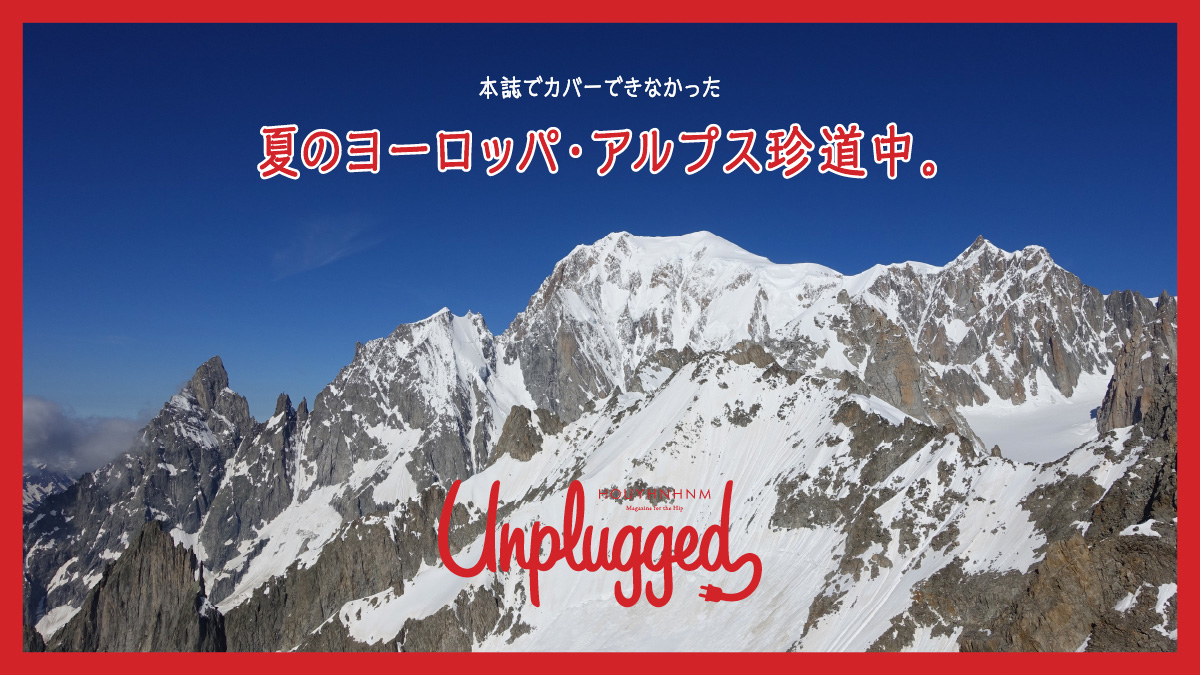


An hour's drive from Turin, Italy's fourth largest city, will take you to the European Alps. To the northwest is Monte Bianco (Mont Blanc in France), and almost due north is the Matterhorn.
Monte Bianco/Mont Blanc borders France and the Matterhorn borders Switzerland.
In this issue, we covered the villages at the foot of the Matterhorn, Cherbinia in Italy and Zermatt in Switzerland, but Mr. S of the tourist bureau also took us to the French border, namely Monte Bianco. Due to space limitations, we were only able to introduce a little in this issue, so we will follow up here.
Monte Bianco/Mont Blanc also has villages at its foot on the Italian and French sides: Courmayeur and Chamonix, respectively.
Courmayeur on the Italian side is famous as the start/finish line of a mountain race called "Tordesian. This is a grueling trail running race with a maximum elevation of 3,300 meters and a total length of 330 kilometers in less than 150 hours. Some people in Japan may know of this race as NHK has made a special program and several athletes have entered the race.
Chamonix, on the other side of the mountain, is one of the world's most exclusive ski resorts, and is also known as the site of the first Winter Olympics held in 1924. In other words, it is the birthplace of the Winter Olympics. Monte Bianco/Mont Blanc rises high in the sky between these villages.
The gondola that offers a close-up view of Monte Bianco was renewed last year. If you have come all the way here, it would be a shame not to take the gondola.
The official name of this gondola is "SKYWAY Monte Bianco," and it is divided into two sections: the first section has a capacity of 80 cabins. The second section has a capacity for 75 passengers. During the trip, the cabins slowly rotate 360 degrees to provide a panoramic view of the glaciers and Alpine mountains. No matter where you are, you will never miss the spectacular view.
The boarding station is located at an altitude of 1,300 m. It is equipped with a parking lot and attracts many tourists.
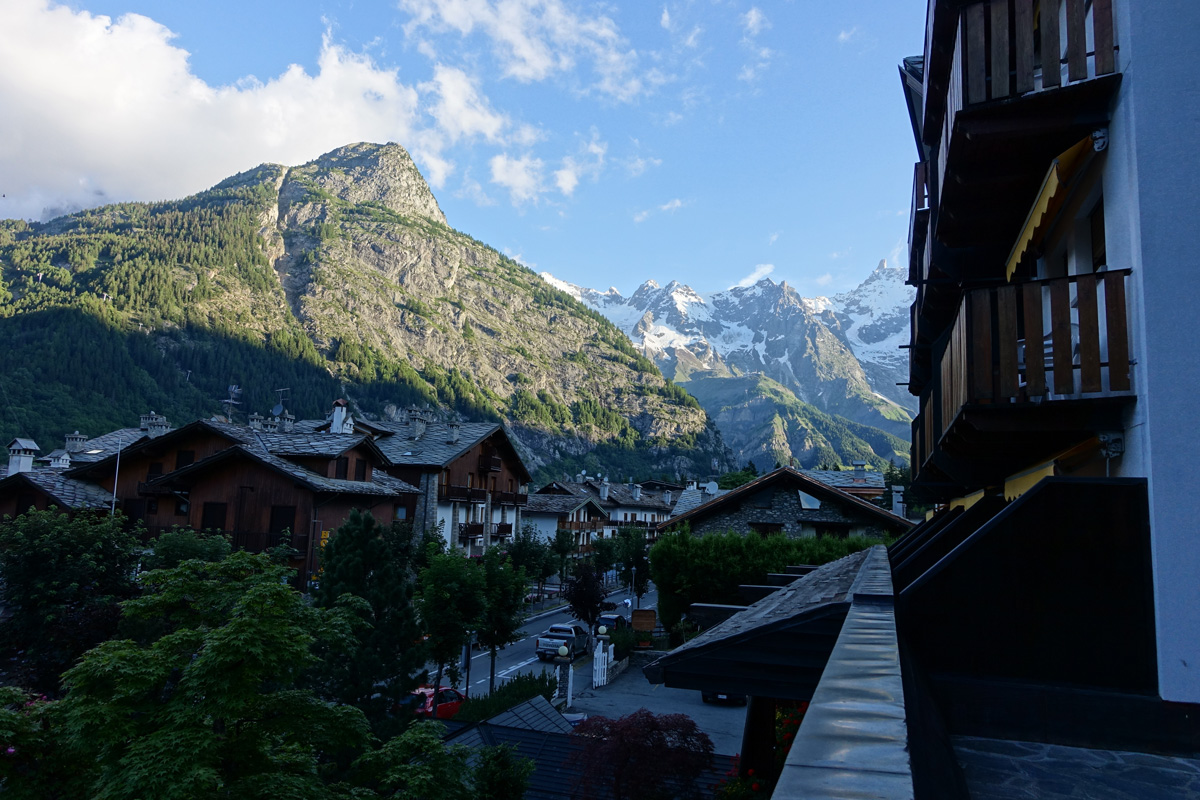
Village of Courmayeur
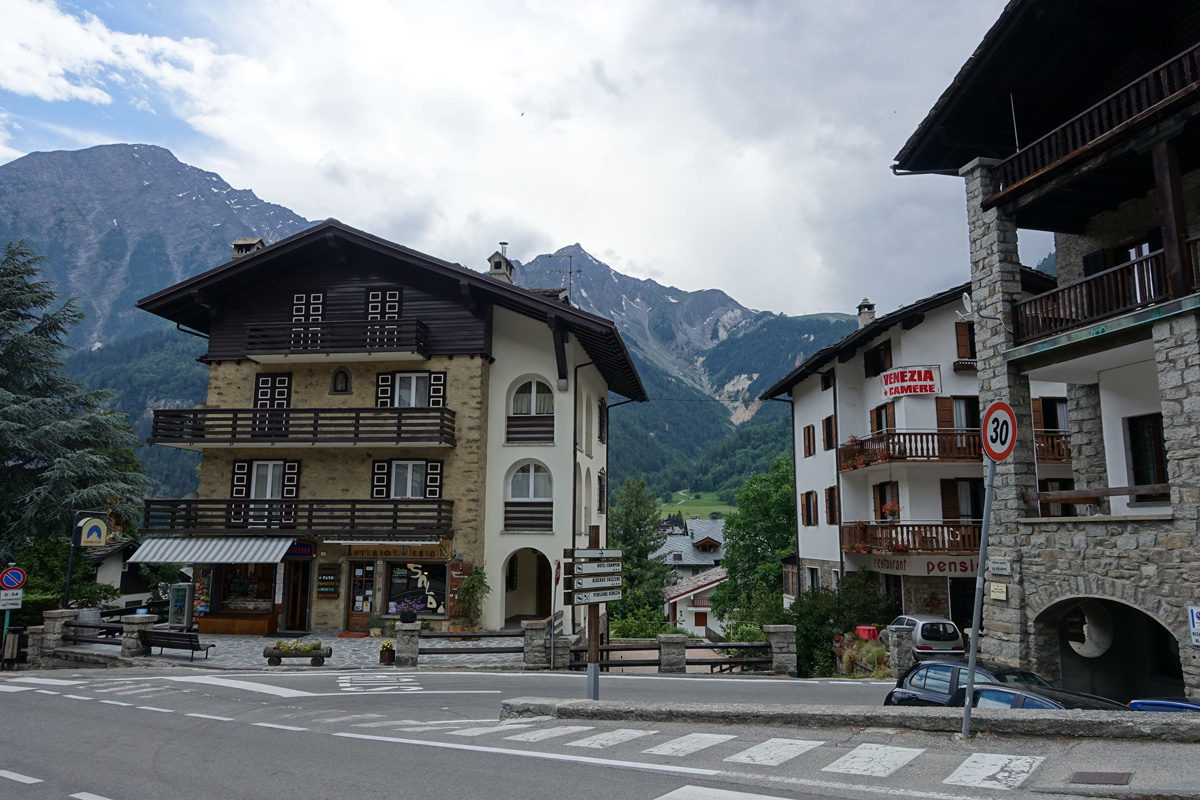
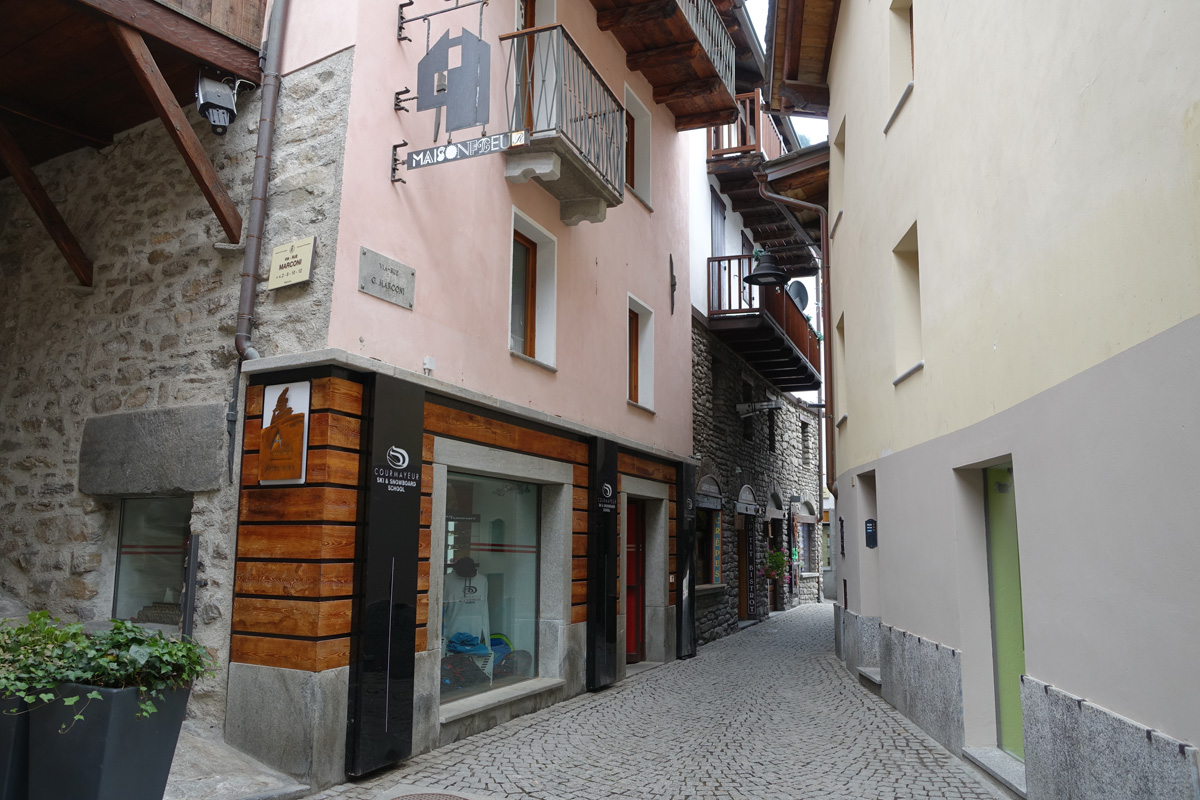
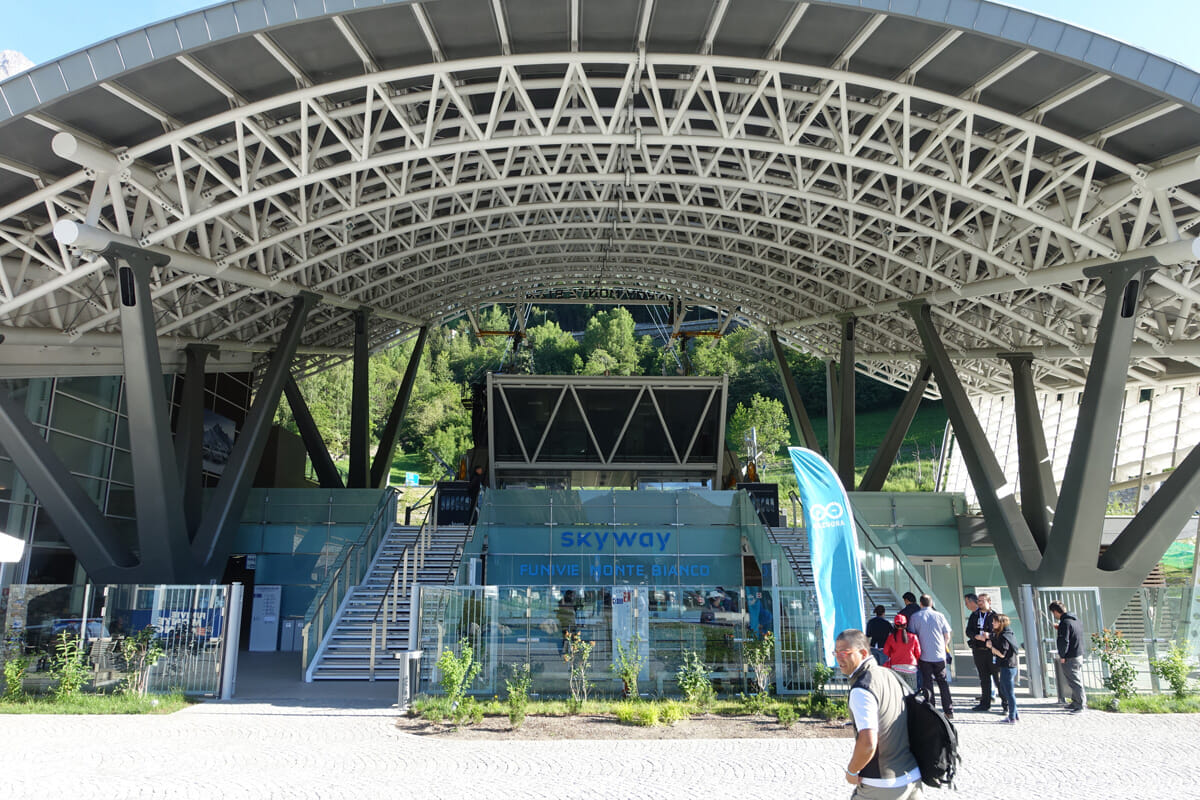
Skyaway boarding gate.
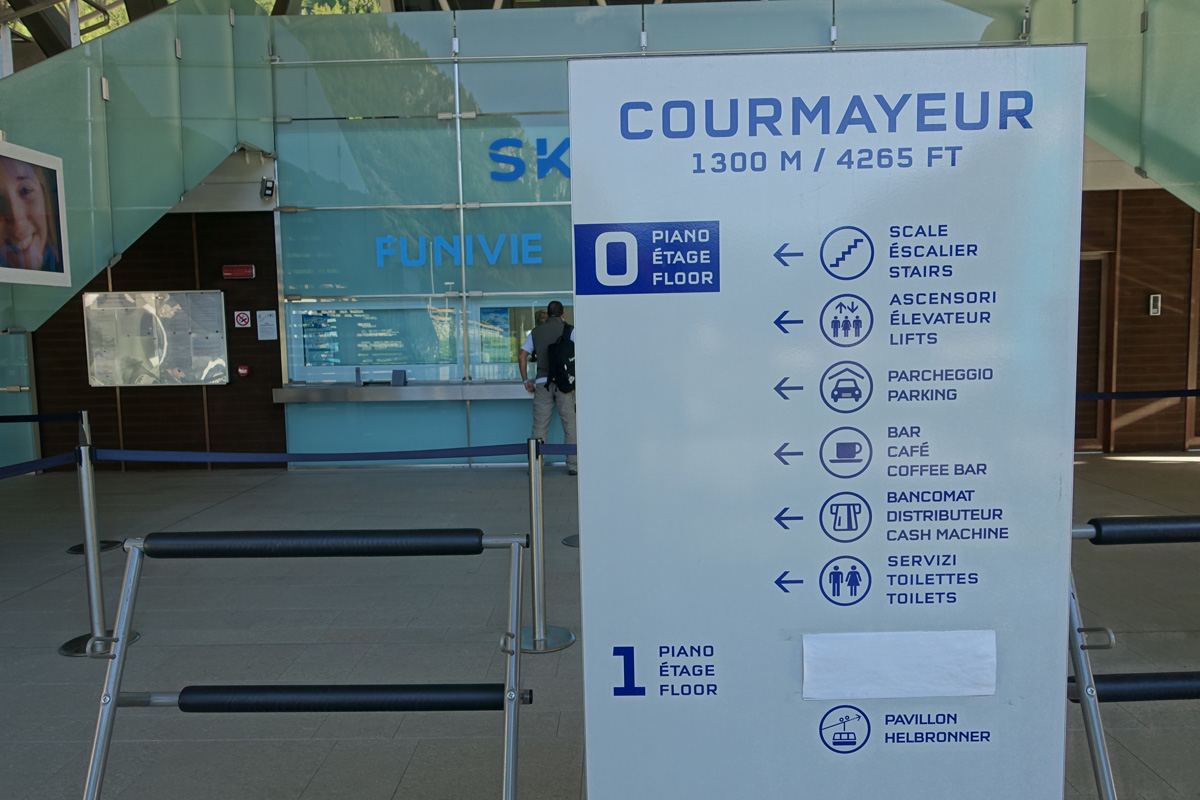
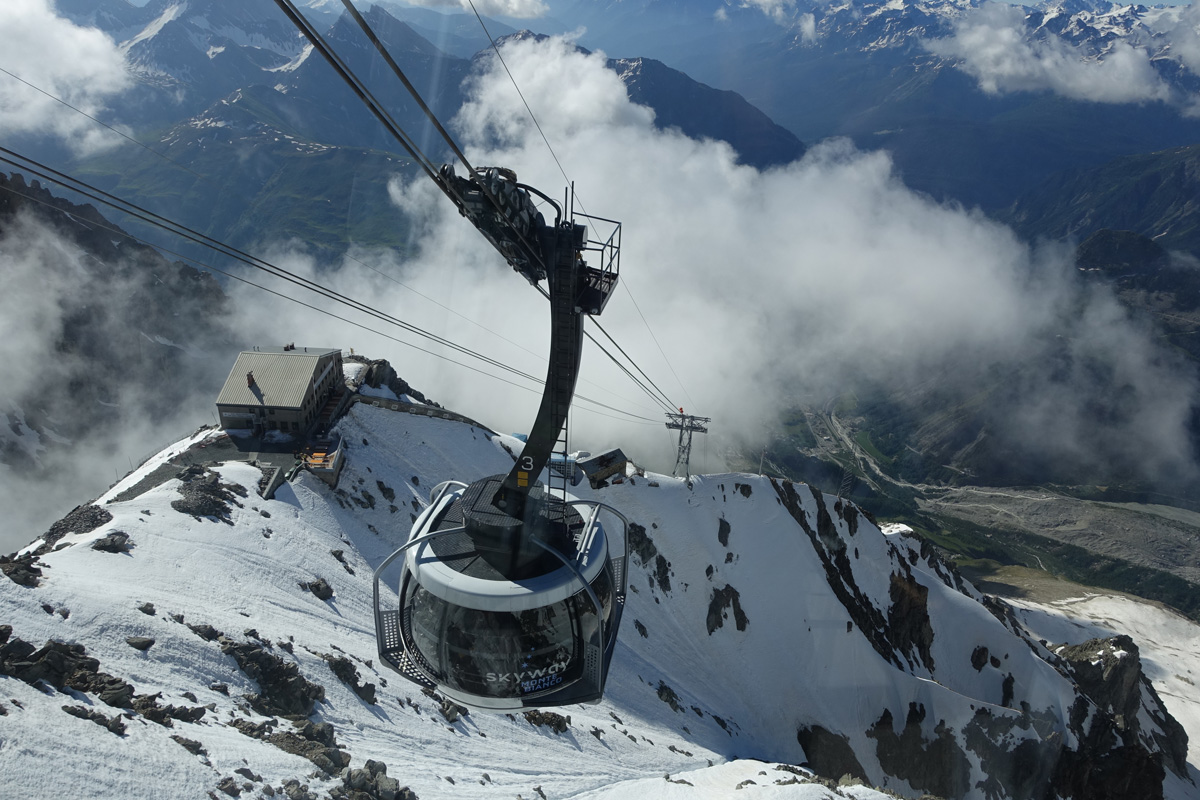
We went to the relay transfer station, Pavillon du Montfretty, at a fairly fast pace. It looks small, but imagine its size, as it has a capacity for 80 passengers. We climbed dynamically while looking at the glacier up close, but the oxygen was getting thinner and thinner.
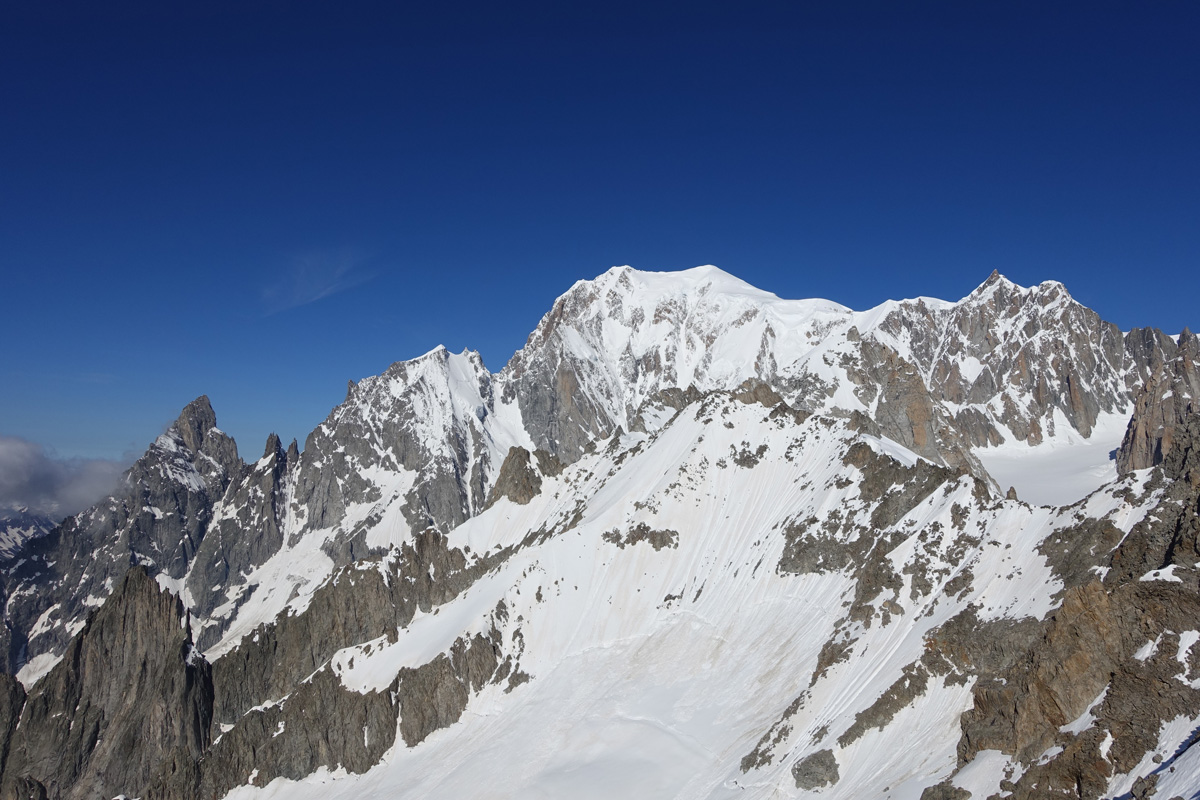
Monte Bianco from El Bronne Lookout (3,462 meters above sea level). Since it does not have the same recognizable character as the Matterhorn or Mt. The left side of the two points is the Italian side and the right side is the French side. The Italian side is rocky and the height is constant, while the French side is surrounded by ice, so the height changes slightly from year to year. The two sides have been repeatedly debating which side is higher, as they do every year. It is said to be like a children's quarrel.
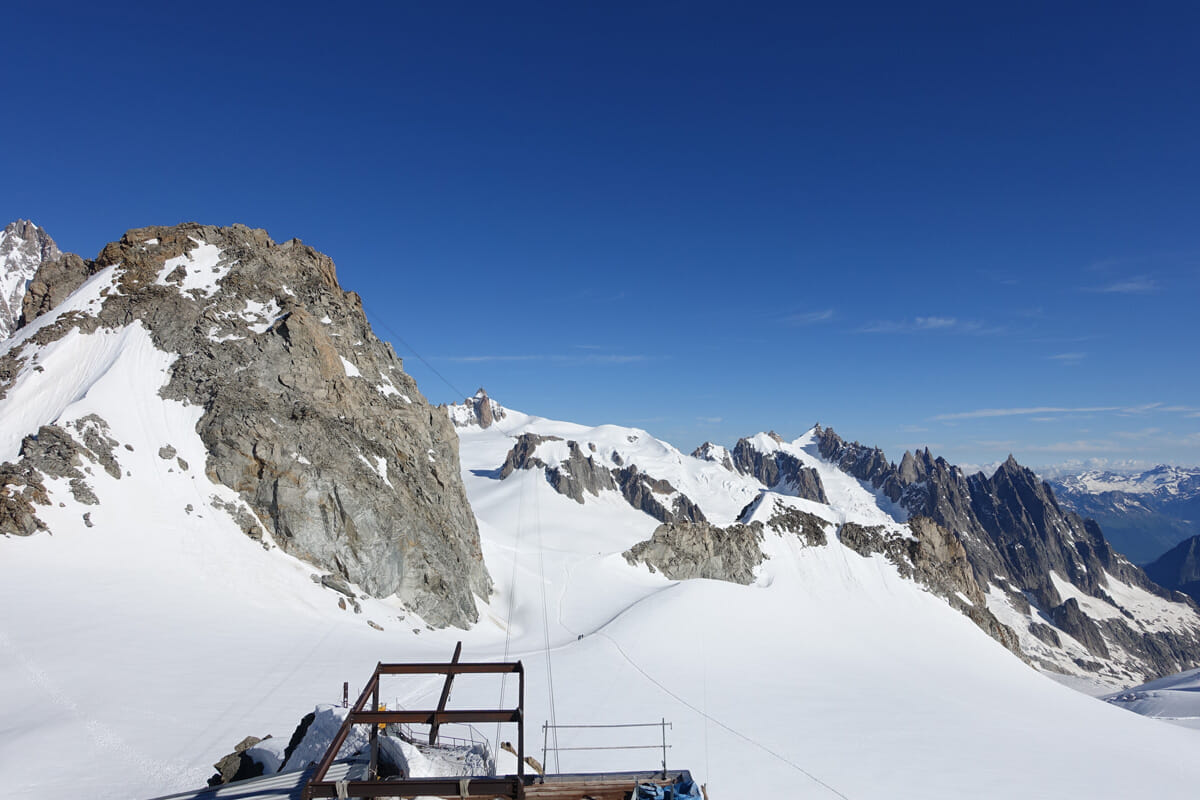
Looking toward the French side from the El Bronne lookout. The wire extending from the bottom toward the center of the photo is the ropeway leading to the French side. The small projection ahead (with the wire extending to the upper left) is the station and observatory on the French side.
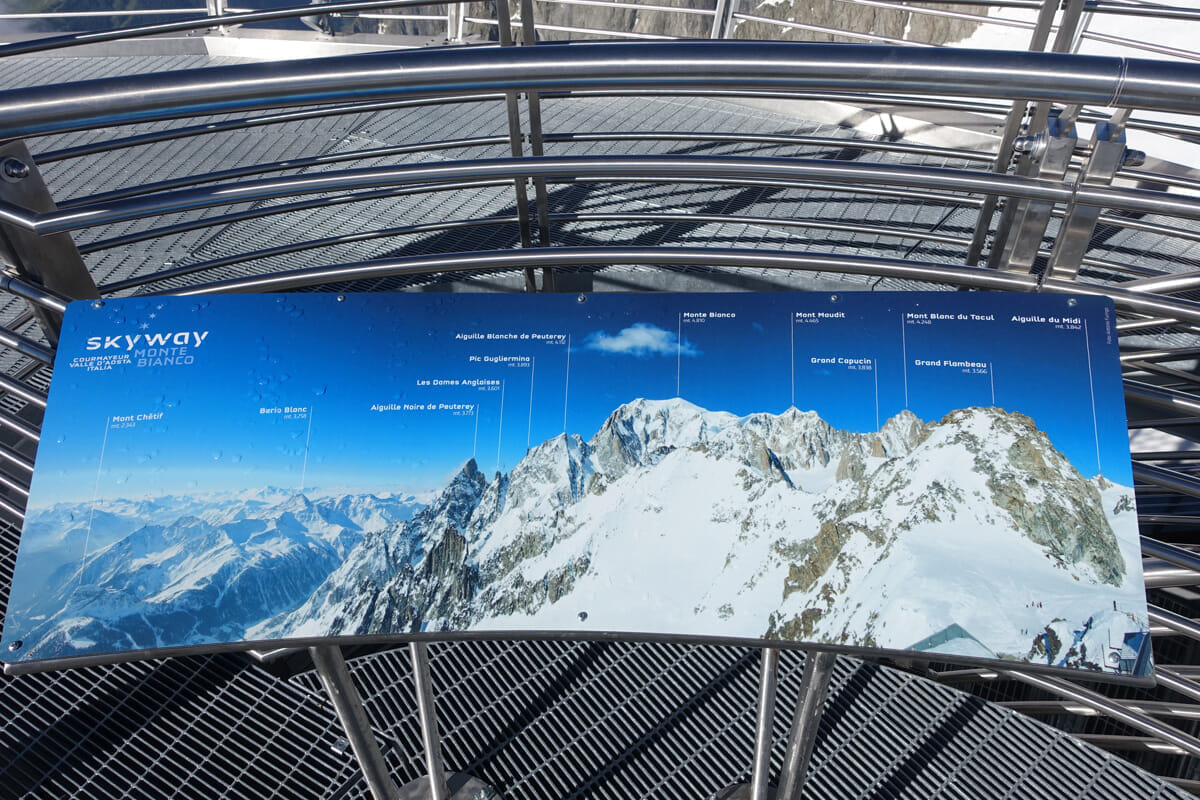
A signboard with the names of the mountains at the observatory. The names of the mountains are not familiar to Japanese people, and they have no characteristics, so it is difficult to understand what they are about.
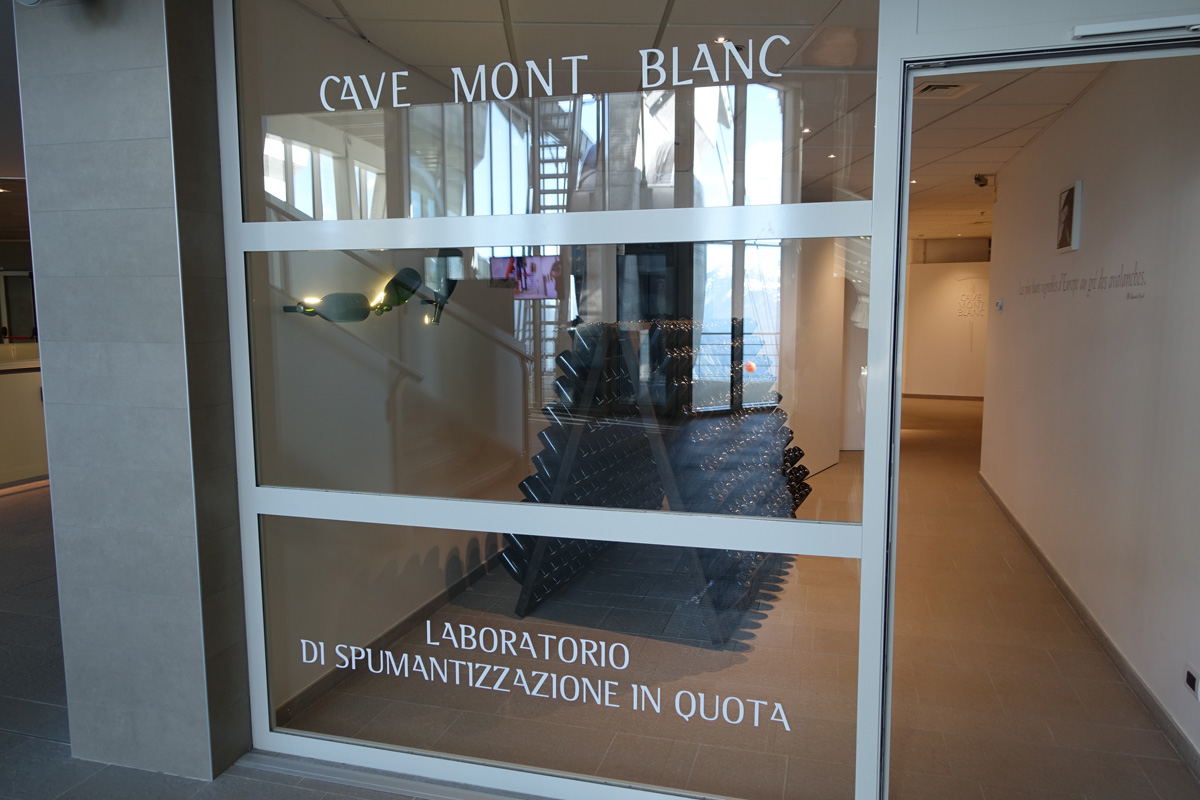
Below the observatory is a bar, restaurant, and even a sparkling wine carve.
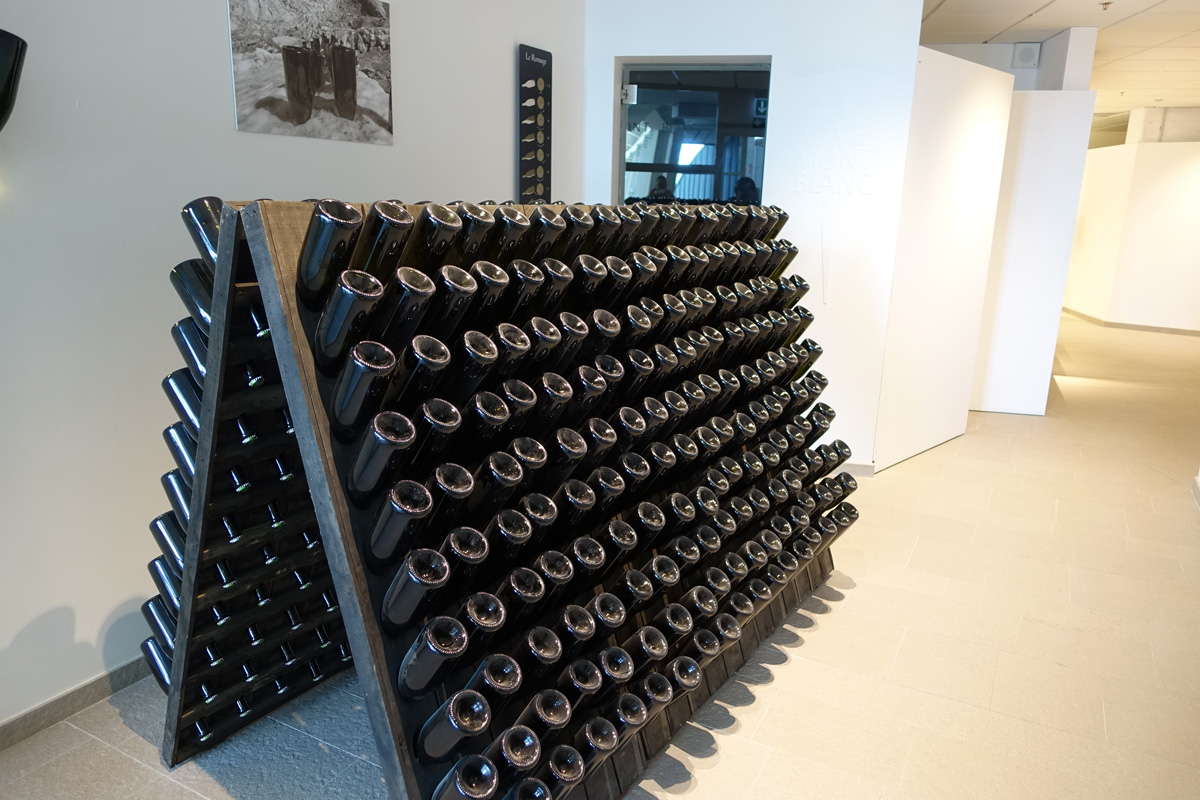
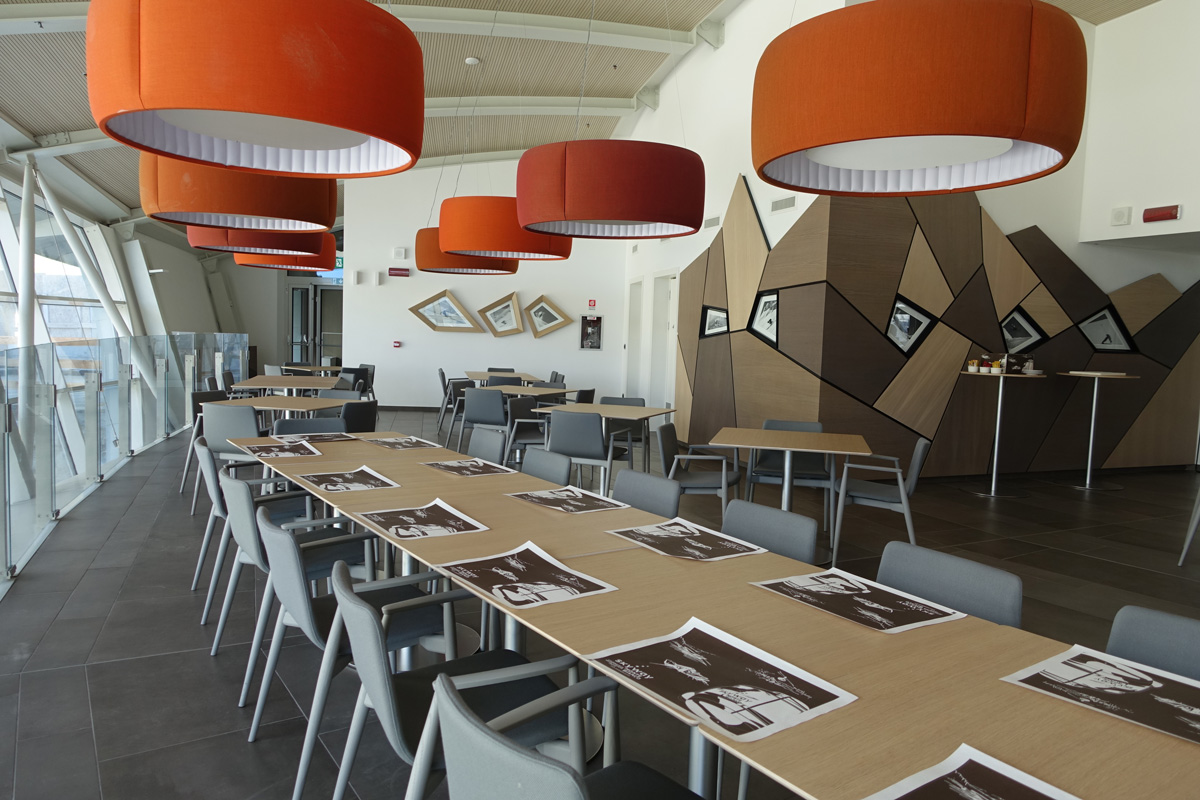
It takes about 15 minutes to reach the 3,466-meter observation deck, including the transfer. It is a short ride, including transfers, to the observatory at 3,466 meters.
We disembarked from the gondola at the observatory station and ascended the stairs to the observatory, but I couldn't help but catch my breath, perhaps because I had been brought to such a high altitude so suddenly. I thought about the people who are challenging 8,000-meter peaks. I think about those who challenge 8,000-meter peaks, and how different they are from us.
Luckily, the weather was fine. From the observation deck, you have a 360-degree panorama. We could also see the lookout tower on the French side, and Mont Blanc sat dazzlingly in front of us as if it had been waiting for us. The view was so spectacular that I couldn't move for a while. Or maybe it was because I was out of breath.
This gondola was built before the last war. The Italian government of the time had them built in order to gain an advantage over the enemy approaching from the other side of the mountain. To tell the truth, I wondered if there was an army that would be able to cross such a steep mountain to attack us. It seems that even after crossing the mountain, they would be too exhausted to be of any use.
Those were the days when there were no such concepts as tourism standards or heritage maintenance. It was a time when people were free to drive a wedge into the wilderness or dig a big hole with a machine. Thanks to this, today, for a nominal fee, one can climb to the top of a mountain over 3,000 meters high, even in high heels. Although, as one might expect, a cold jacket is required even in summer.
All the materials for these observatory facilities were transported by helicopter. The question of whether they were transported by gondola or helicopter is an interesting paradox: chicken first or egg first.
Just as we were visiting, a helicopter was carrying some kind of material on a rope at a very loud volume. From the perspective of our daily life, every single thing was on a grand scale.
It was an interesting experience.
When we were about to leave Courmayeur for Cherbinia, Mr. S. from the tourist office asked us if we would like to take a scenic flight since the weather was so nice. He told me that there was a small airfield in the town of Aosta, where I would be relaying my flight, and that there was a flying club there.
You can clearly see from the Matterhorn to Monte Bianco."
Travel is extraordinary. It sometimes prompts people to make tremendous errors in judgment.
Let's ride!"
In an hour we were at the airfield. A small airplane is called a Cessna by its trademark name, and this is such a small airplane. It has a capacity for four passengers.
The pilot was said to have served in the Italian Air Force, but he was too old and jovial to be trusted. Still, the engine produced a loud exhaust note.
When I was in the passenger seat, every time my uncle operated the controls, my arms, knees, and other parts of my body would bump into him. That's how small the cockpit is. Moreover, the control stick extends from the floor and is positioned between my knees, and there are pedals on the floor within reach of my feet. We were told beforehand never to touch any of the controls. However, when the plane suddenly jerked and descended, I looked for a place to hold on to, but there was nothing like a handle anywhere, and I unconsciously gripped the control stick. Unpleasant perspiration gushed out from all over my body.
Once in stable flight, it is just like the plane you normally fly, and you will spend a boring time watching the scenery that moves only gradually.
On the way, we will cross over a village called "Chamois". It is a small village with a population of about 100 people, and is known as the "Pearl of the Alps.
It is a self-sufficient village on top of a mountain, accessible only by gondola or small plane. There is no road leading to the village. It is a completely isolated village. Researchers from all over the world are said to come here to conduct research from a cultural anthropological viewpoint. Of course, Japanese scholars often visit the village. It is the ultimate in eco-friendliness.
At this point, the Matterhorn is already close.
However, the fine weather that had been continuing up to this point gradually gave way to clouds. The early morning skies are relatively clear, but at this time of year, the temperature rises after 10:00 a.m., and water vapor rises to the surface and forms clouds.
We looked ahead to see people enjoying skiing at the Plateau Rosa in Gletscher Paradise, but we could only catch a glimpse of the Matterhorn's summit through the clouds. The cloud cover was increasing, so we were forced to turn back on the advice of an old man who said it would be dangerous to continue on our way. Too bad, Matterhorn. See you again in Cervinia.
I would like to spend another tedious hour writing about the flight to Monte Bianco, but the plane shook unexpectedly on the way there, causing me to panic a little. It was not the whole plane shaking up and down or side to side, but only the buttocks sliding side to side. It's a weird feeling that I've never experienced on any ride before. It was like a poorly made amusement park attraction.
Monte Bianco, like the Matterhorn, was blocked by clouds. I could catch a glimpse of the top of the mountain, however, and I gave him a sign to hurry up and get off the mountain, as if to say, "We've been looking at it for a while now, so it's okay.
Landing is done by gradually decreasing altitude. Because a sudden descent would be bad for one's health, the aircraft is circled and descended at an angle over Aosta in a circular motion over and over again. It is also bad for your health to keep looking at the scenery from an angle for about 10 minutes.
By the time we landed on the runway, my body was already limp.
Thank you, Uncle. I will never ride again.
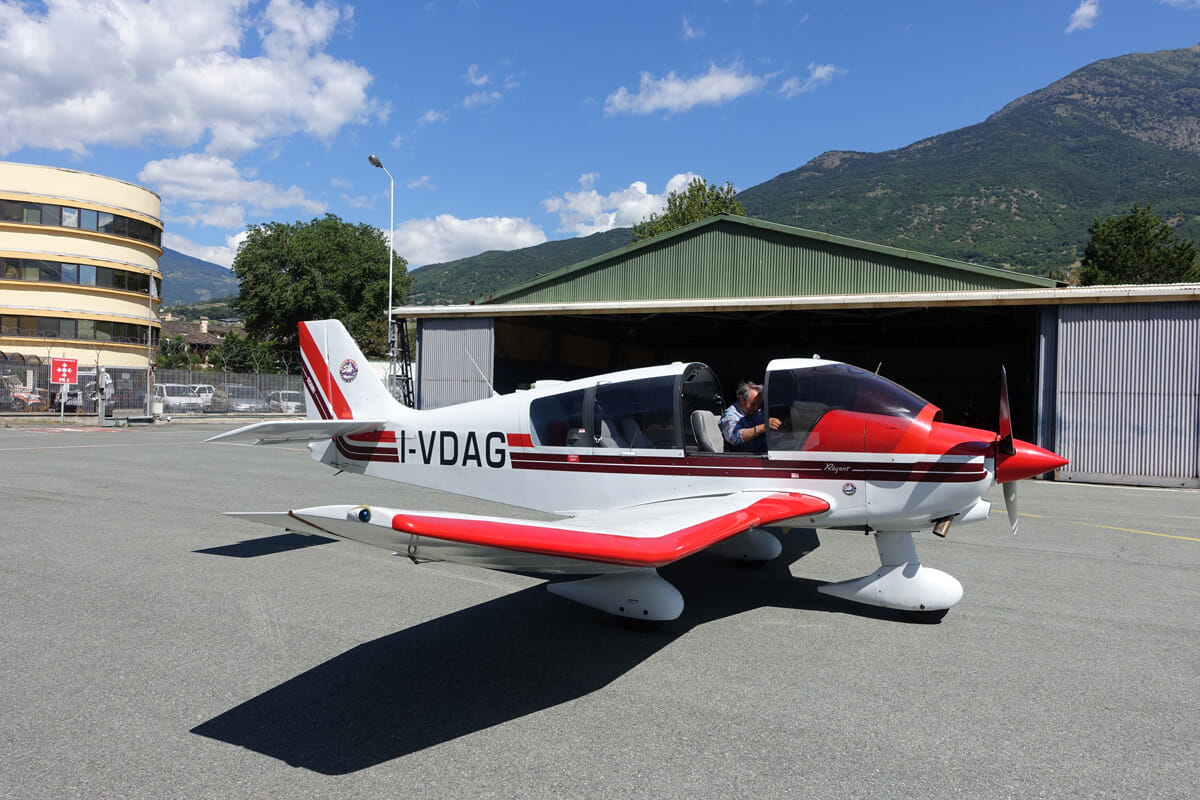
This is an airplane. It is like a light four-wheeled vehicle.
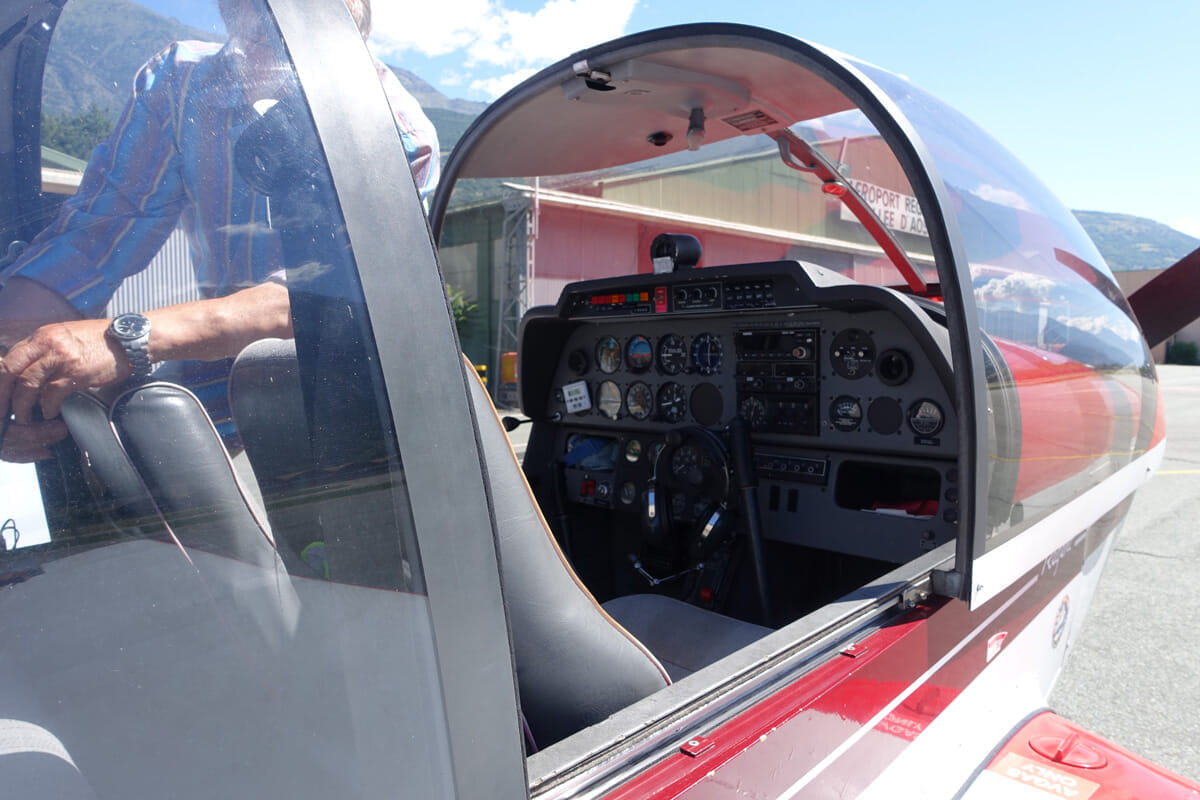
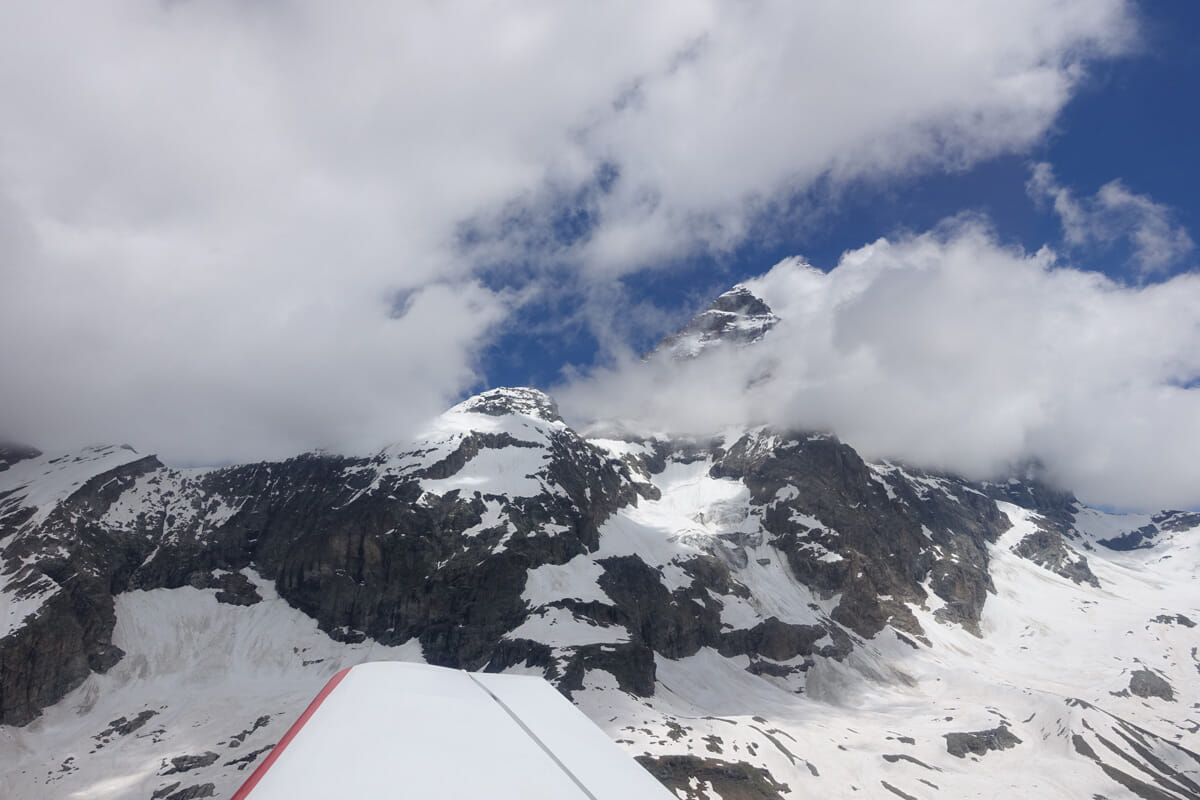
The Matterhorn hidden by clouds. The view from the Italian side.
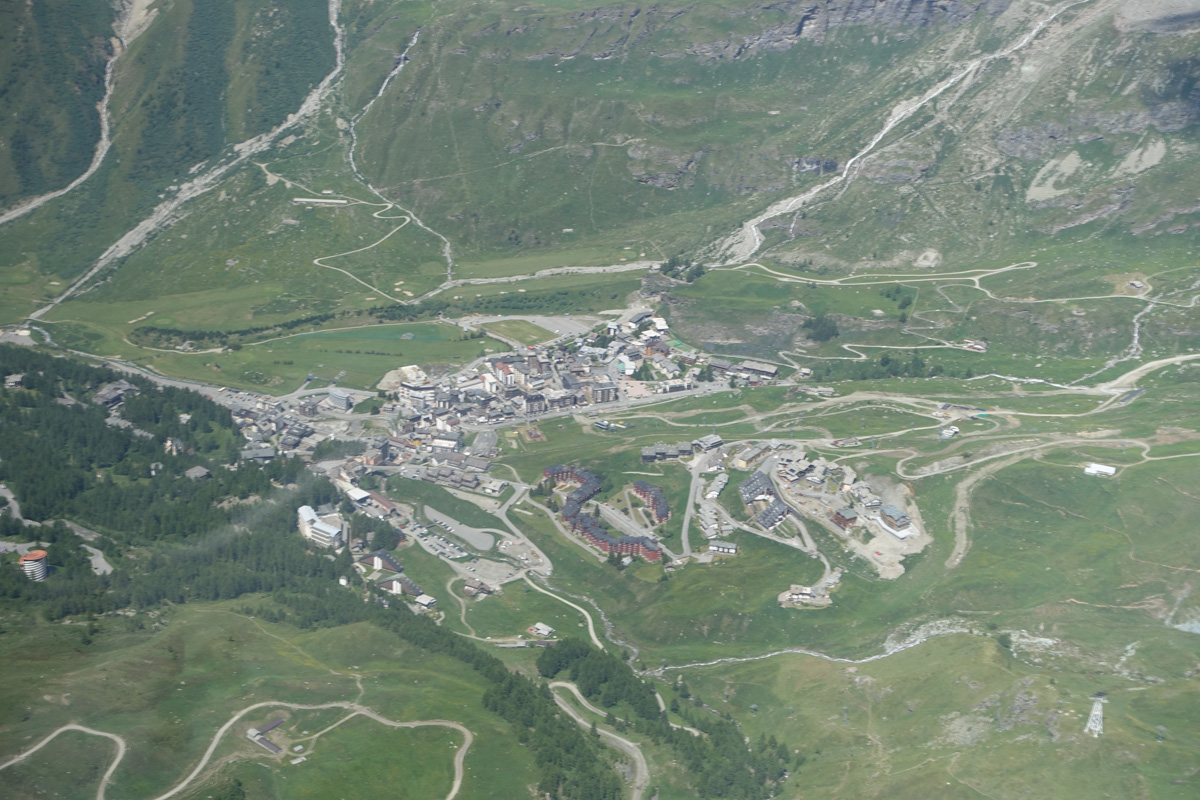
Cherubinia village seen from above.
Cherubinia. Pronounced "cherubinia" by the locals. The sound pull is very Italian.
It is a small village that can be circled on foot in about 15 minutes. It is a spartan ski training camp where ski teams from all over the world visit in the winter, but it is also a tourist destination, so it is also worth a visit as a resort. After all, this is Italy. Prices are totally different from those in Switzerland, which is located on the other side of the mountains. Moreover, Italy is a country where the food is delicious no matter where you eat. In terms of food satisfaction and cost performance, it is the best in the Alps. In fact, people who stay in the Swiss side and enjoy skiing come to this side for lunch and eat cheap and delicious food.
And close to the Matterhorn. No, it wasn't. Cherubino. In Italian, this is what the Matterhorn is called.
The village is realistically at the foot of a mountain. Unfortunately, the shape of the mountain is a little behind the Swiss side. From the Italian side, it looks like a craggy rocky mountain. As an impudent third party, we feel that there must be no complex. It is like the B side of the Matterhorn.
The village was empty; after the winter season, which ends at the end of April, May and June are off, and the summer season has just started in early July.
So you can relax. You can enjoy sports, eat delicious food, and drink at the bar, and it is still light. This also adds to the relaxed mood. The Euro quarterfinals between Italy and Germany had just been played, and the locals were having a great time at the bar, but after less than two hours they had fallen silent.
In summer, Cervinia is a mecca for outdoor sports. Not only mountain climbing and skiing, which are introduced in this magazine, but also trekking, trail running, downhill biking, and even golf. The gondola up the mountain is within walking distance, so you can stay at any of the inns in the basic village.
We had to change gondolas twice to get to the ski slope. It was a weekday, so there were a lot of kids who looked like local junior and senior high school ski club members. This is where the next Tomba will be born. The environment of being able to ski all year round is more advantageous than anything else.
Gresher Paradise, where skiing is possible, is at a high altitude, so after a few runs, I was still out of breath. The local kids were repeatedly getting caught on the T-bars, climbing and sliding up and down. Yes, this is not a lift, but a T-bar.
A T-bar is literally an ascending device in which a T-shaped bar extends from a wire above you, which you catch, hook onto your buttocks, and ski up and down. It is impossible to put a permanent structure on an unstable glacier that is gradually moving. Therefore, simple T-bars that can be temporarily installed are the standard for glacier skiing. Skis are relatively easy to master, but as mentioned in this magazine, skiers seem to have a knack for it. The writer, Mr. M, also struggled at first.
The slopes will be open until 1pm. The slopes are closed before the temperature rises and the surfaces become rugged, and the next morning the slopes are acclimated at Pisten. The process is repeated. The conditions are very good because it snows at night even in summer. If you come here not for work but for fun, it is not a bad idea to enjoy one-round skiing in the morning and play golf or tennis in the afternoon.
As for lodging, Santo Ubertos, featured in this magazine, was exceptionally good. Not only is it located right below the gondola station, but all the rooms have fireplaces. I think all the members of the interview team fantasized about coming here for fun during the high season in winter.
By the way, the food is very good in Italy.
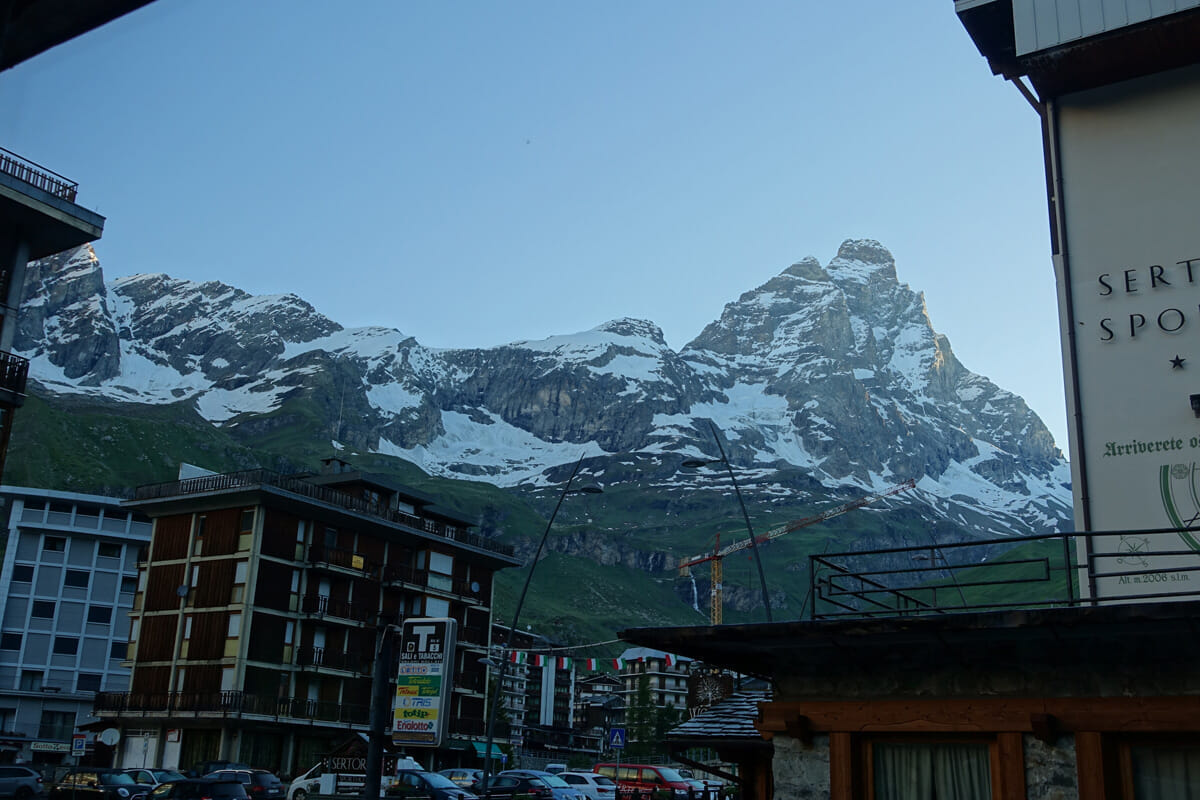
Cherubino (Matterhorn) rises over the city. It is a pity that it looks like just a lump of rock when seen from the Italian side.
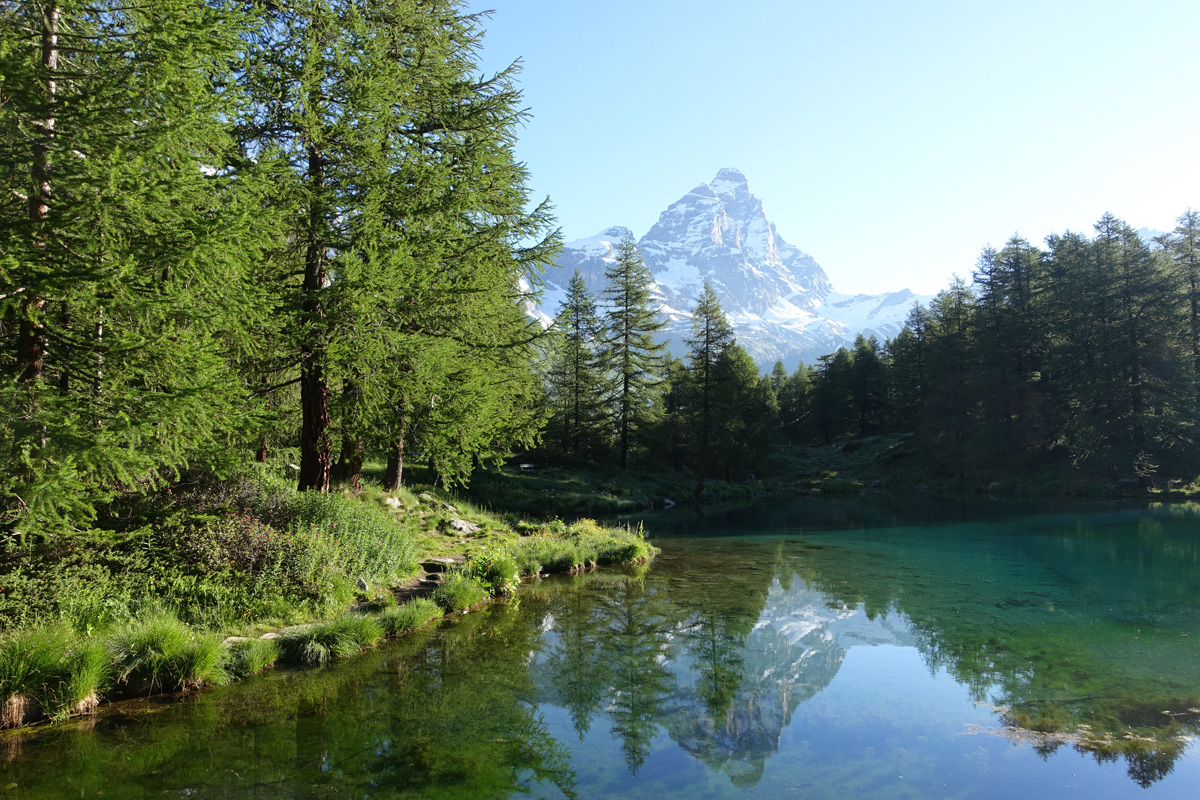
Even though it was a B-side, beautiful things were still beautiful. Upside-down Cherubino reflected in Blue Lake.
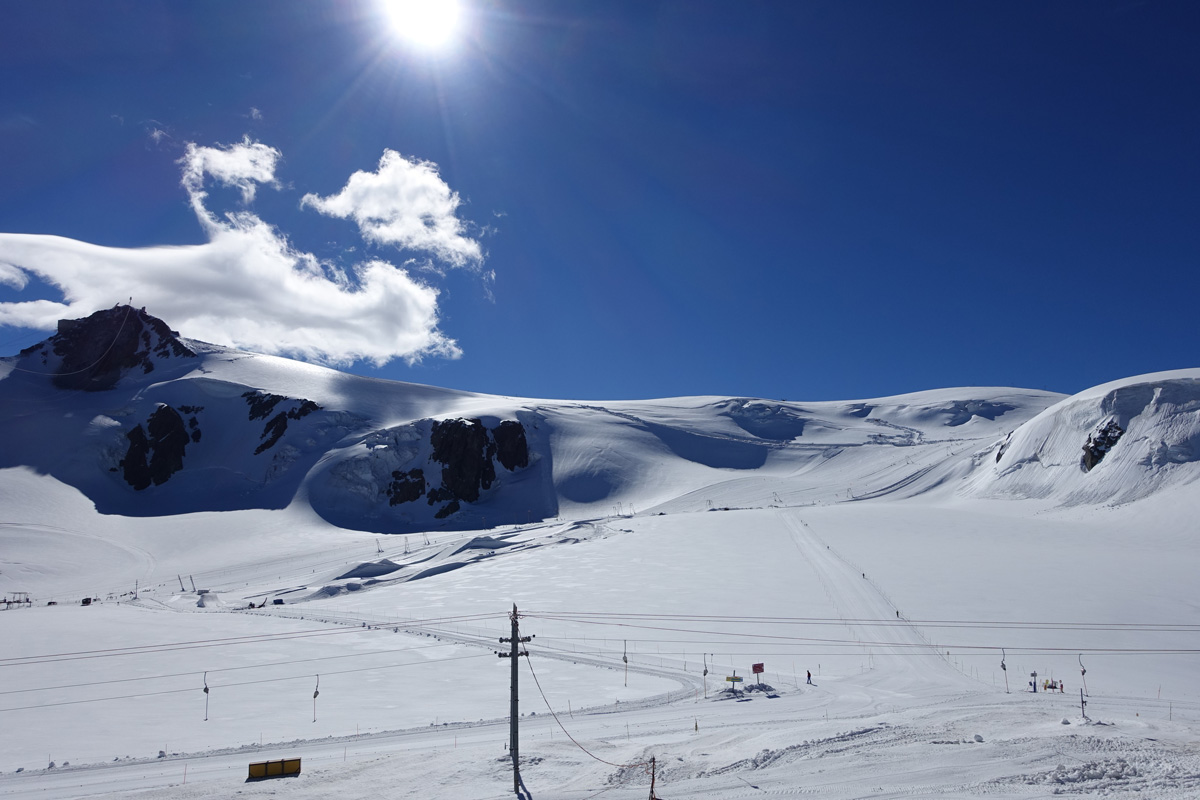
Once you get off the gondola, you will find yourself in a winter landscape. When it clouds over, the temperature drops below zero. However, the conditions were not unlike those of mid-summer.
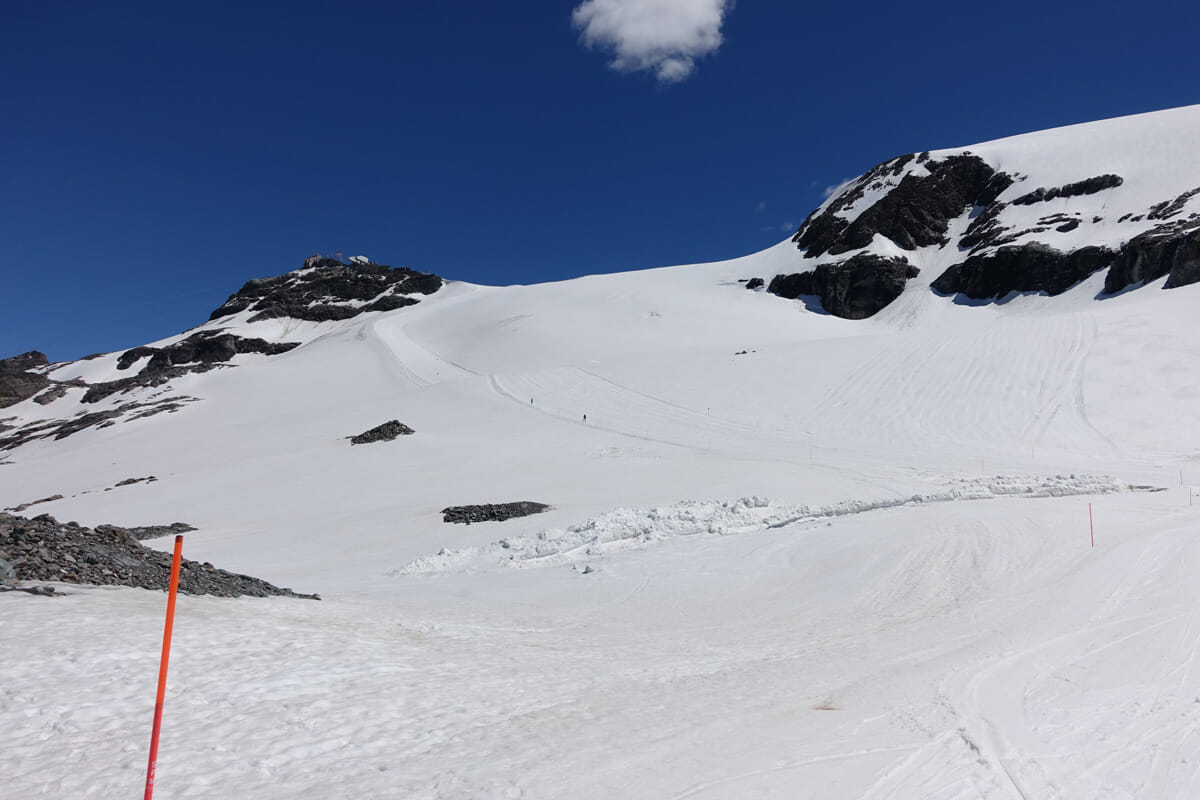
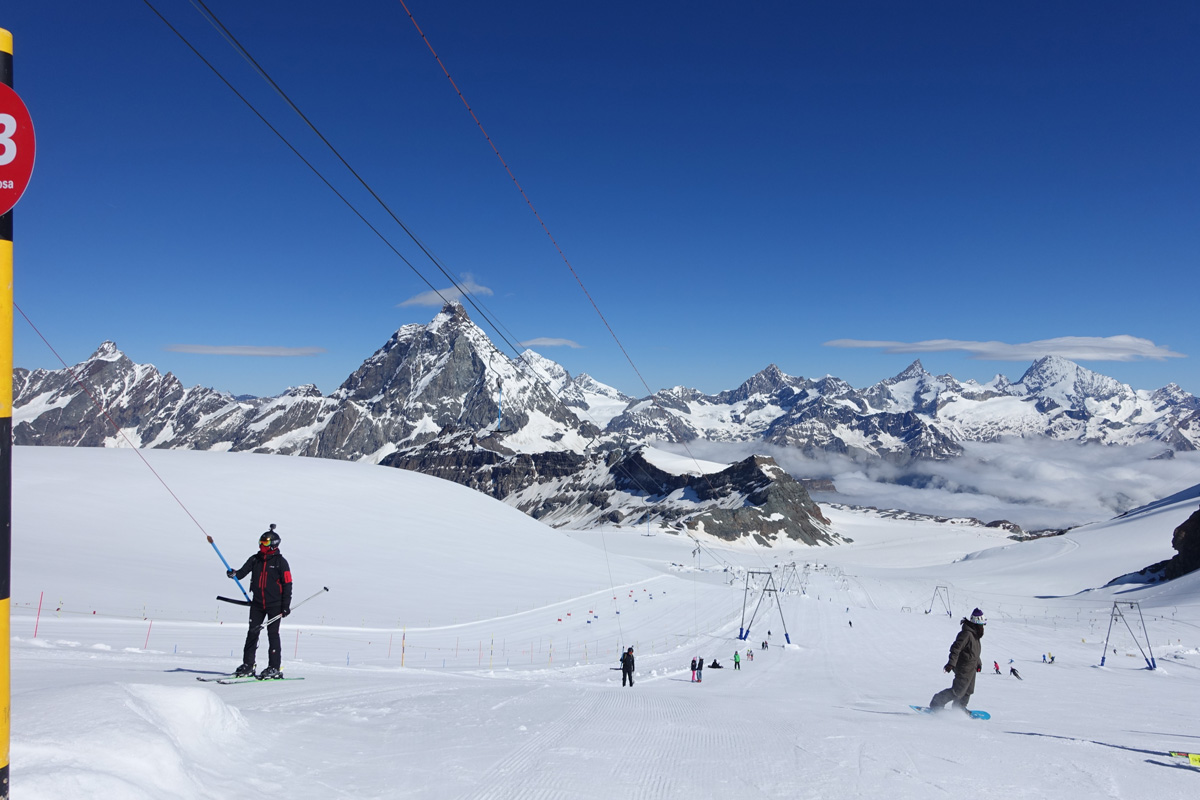
The T-bar is shown on the left side of the photo. It can be ridden by two people.
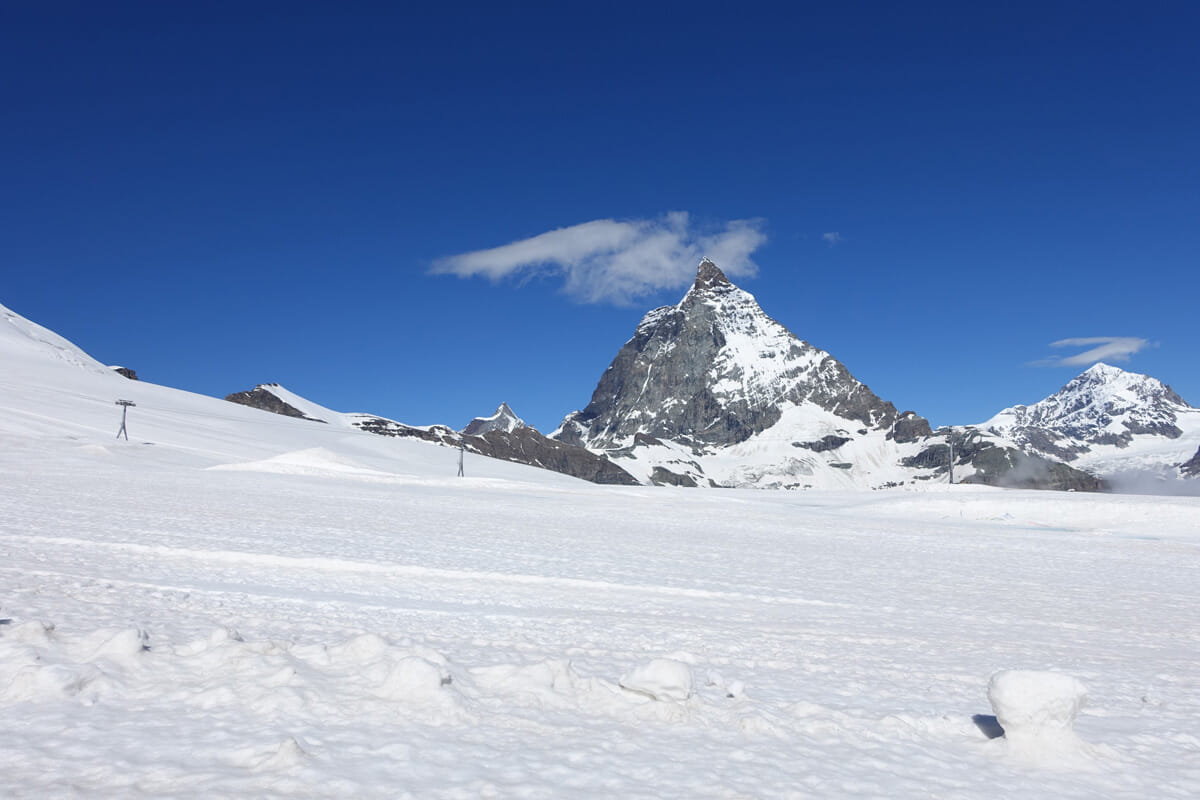
Cherubino (Matterhorn) seen from the slope. The eastern flank is visible.
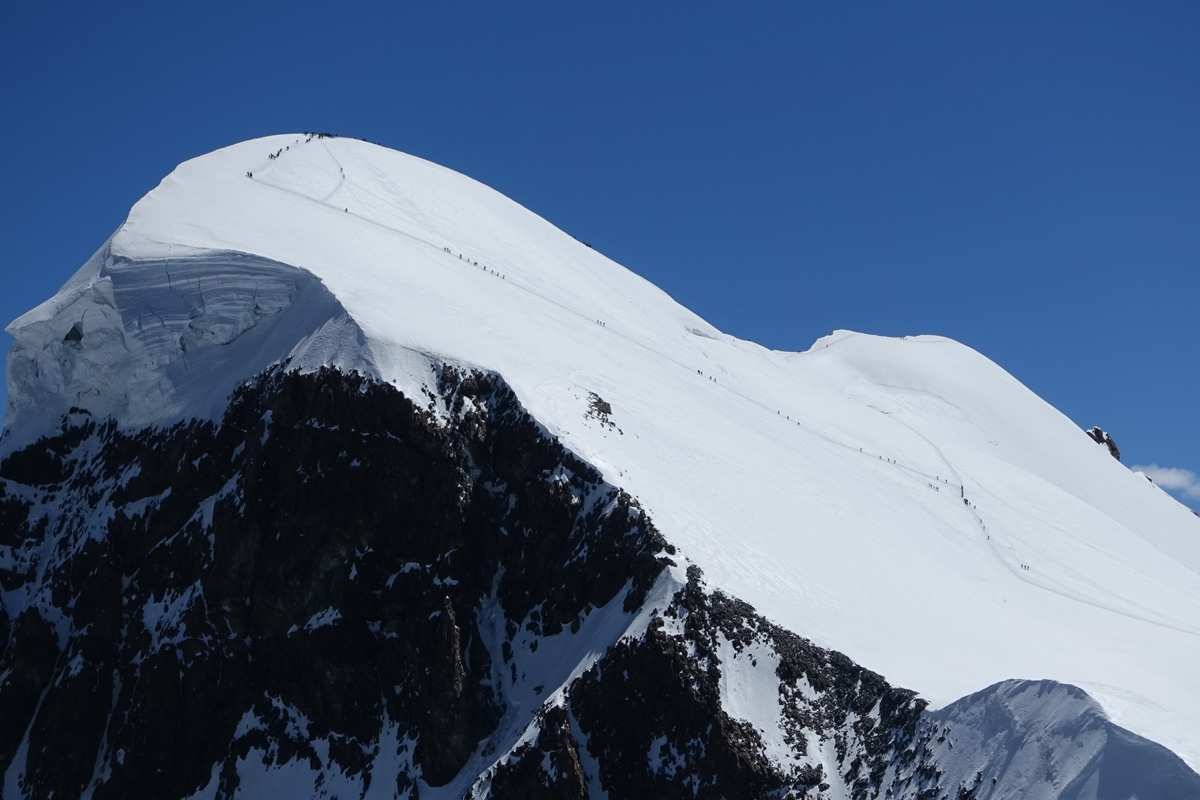
Brighthorn looking up from the ski slope. The dots that look like ants on the streak are climbers attacking the summit. Oh no.
When one thinks of the Matterhorn, the first place that comes to mind is Zermatt. The village where Edward Wimper, the first person to successfully climb the Matterhorn, and his crew stayed for their attack 151 years ago was Zermatt. The village of Zermatt has since become famous all over the world as a tourist destination.
Zermatt is an environmentally advanced village, and gasoline-powered cars are not allowed in the village. All vehicles are electric. Cabs, trucks, bulldozers, and other working vehicles are all powered by electricity. The main street is about 1 km long, and hotels and cottages are spread out around it. Compared to Cherubinia, it is about twice as big. There are also some brand-name boutiques and high-end watch shops, as one would expect from Switzerland. I was surprised to see a surprisingly large number of mature Japanese tourists. In recent years, the majority of Asians have been replaced by people from neighboring countries, but here in Switzerland, there are still lingering traces of Japan's economic powerhouse.
Hotels and restaurants are small, clean and modern. The hotels and restaurants are small, clean, and modern, and are so-called "touristy," which may divide tastes compared to those of Cervinia.
But the Gornergrat experience was wonderful. This is also the name of the mountain, and the hotel is built on a 3,100 meter ridge. The Gornergrat train connects the village of Zermatt and takes about 33 minutes to get there. The one-way trip costs 45 Swiss francs. It is a bit expensive, but it is worth it.
We stayed overnight at the Kulm Gornergrat Hotel on top of the mountain. We arrived at the hotel just in time for lunch, so we had a beer, which was fine, but our photographer, Mr. M, was a little down due to the alcohol in the thin air. The men's team was a bit beaten down by the thin air.
The Monte Rosa at sunset, the Matterhorn at sunrise, and the unobstructed starry sky at night are breathtaking moments. Fortunately, we were blessed with good weather so we were able to experience all of these, but I sincerely sympathize with those who were not able to see them due to a bad turn of events. It was such a worthwhile experience.
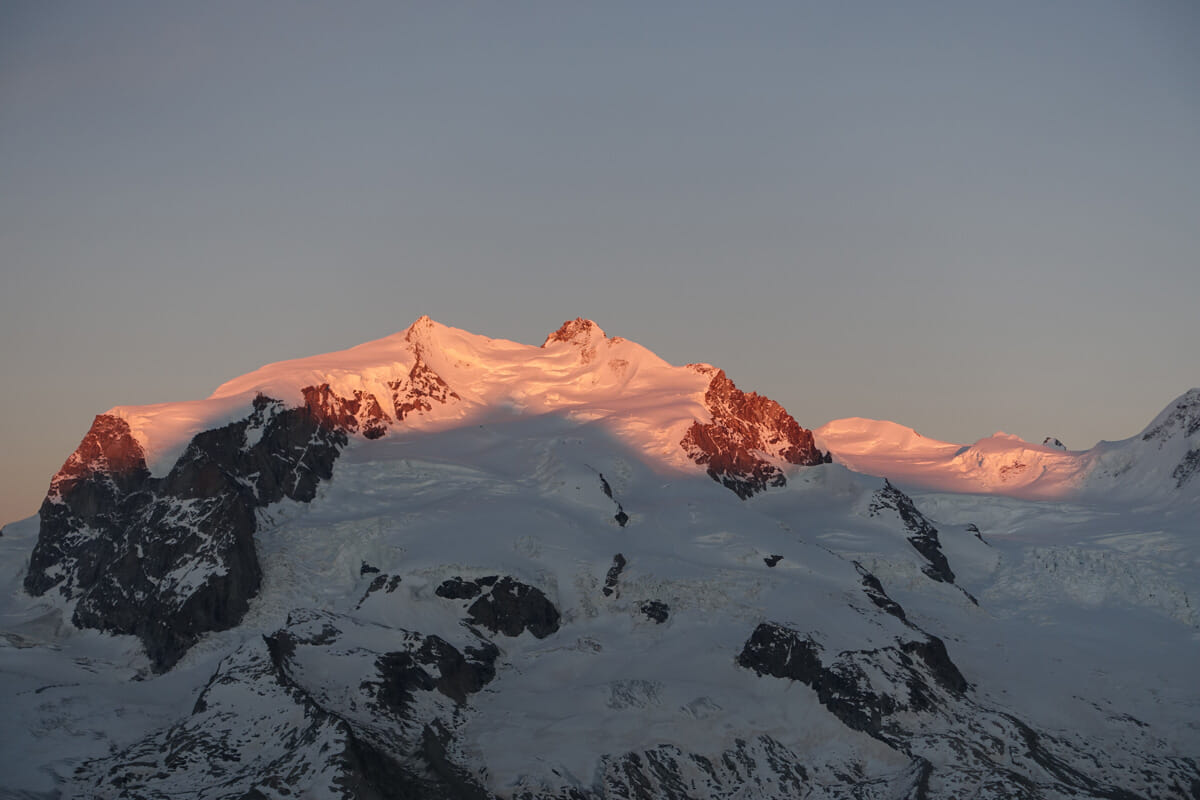
Sunset in Monte Rosa. I asked him if it is Monte Rosa because it turns rose-colored, and he said it is not. Huh.
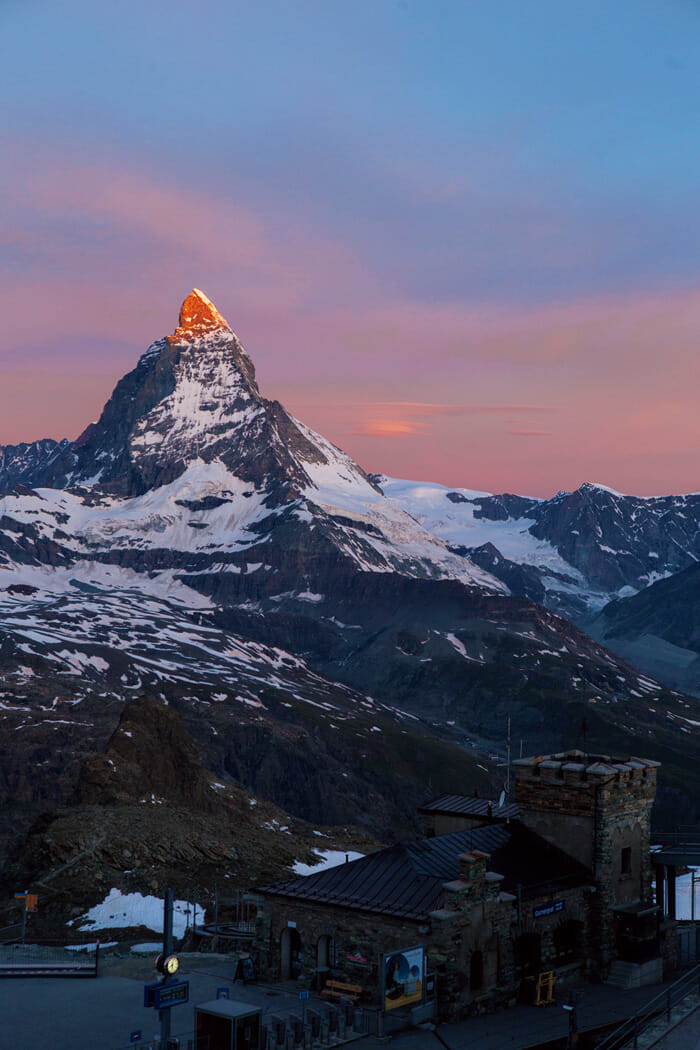
Morning glow of the Matterhorn. Beautiful, isn't it?
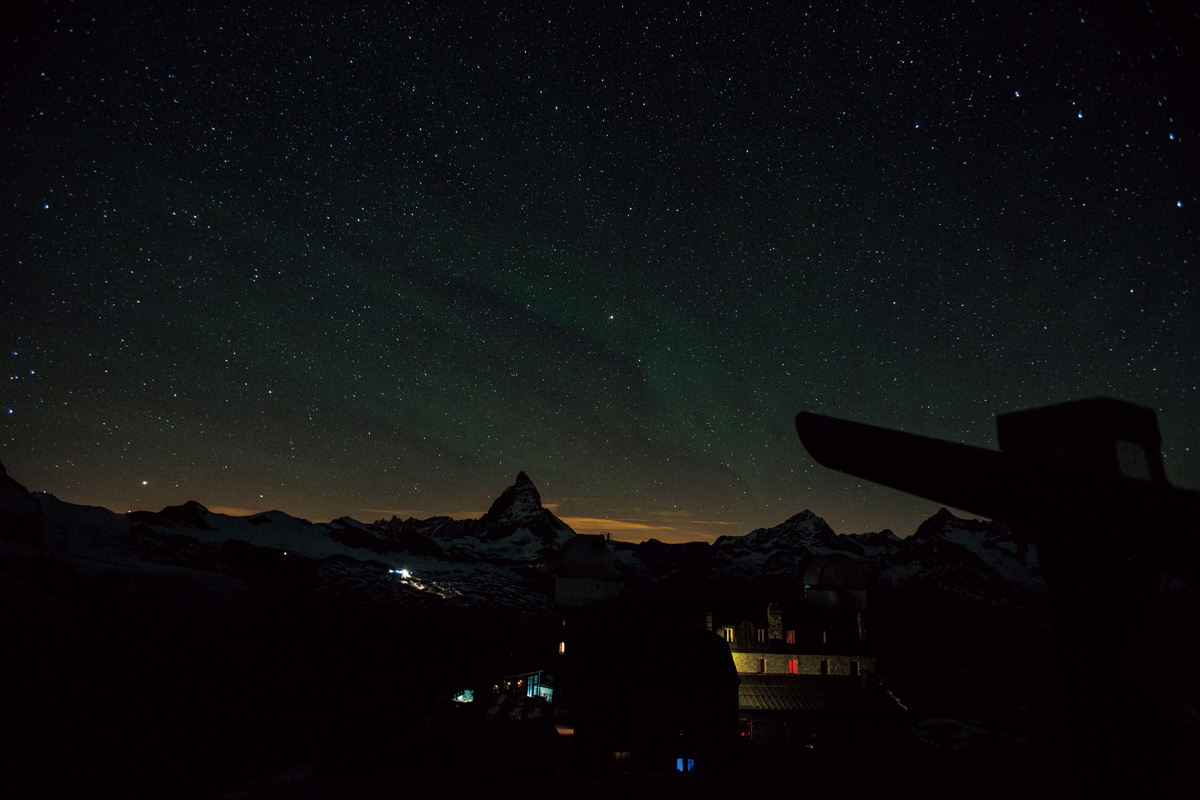
The air is clear, we are above the clouds, and no light from below reaches us. I could not imagine better conditions for stargazing.
I rented a GoPro for this interview. It's a must-have for action sports. It was interesting to play around with it beforehand. I can easily control it from my cell phone. There are three types of lenses: ultra wide, middle, and normal.
However, the photographer was not very good at it, so he could not leave a very good image. Still, it is easier to visualize the skiing scenery than photographs, so please take a look.
Plateau Rosa (does that mean "Plain of Roses"?) in Glescher Paradise. The high mountain in the center or slightly left in the front is the Matterhorn. The high mountain in the center or slightly left front is the Matterhorn. We were blessed with good weather.
A gentle, straight slope leading from Plateau Rosa to Trockener Stec. There are some steep parts along the way, but it is a great course for beginners to get accustomed to skiing. There are some small bridges along the way, which are quite interesting. The Matterhorn can be seen all the way to the left of the course.
Small airplane experience in Aosta. First, let's start with takeoff.
The first gentle snow surface you see in front of you is Plateau Rosa. In other words, it is a ski slope. Turning to the left, the Matterhorn peeks out through a gap in the clouds. It is a pity that the clouds suddenly came up and we could not see it exactly.
We turned back from the Matterhorn and headed back to Monte Bianco/Mont Blanc. Unlike the previous SKYWAY ascent, the clouds blocked my view. Monte Bianco peeked out from the clouds.
